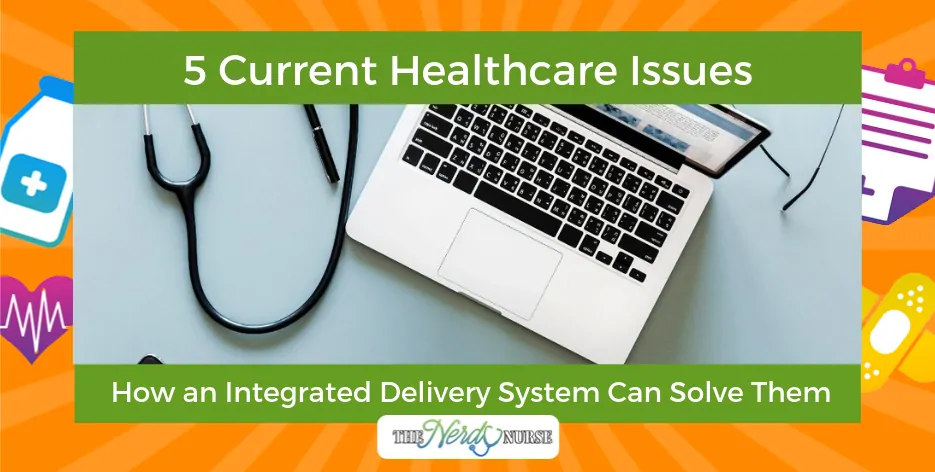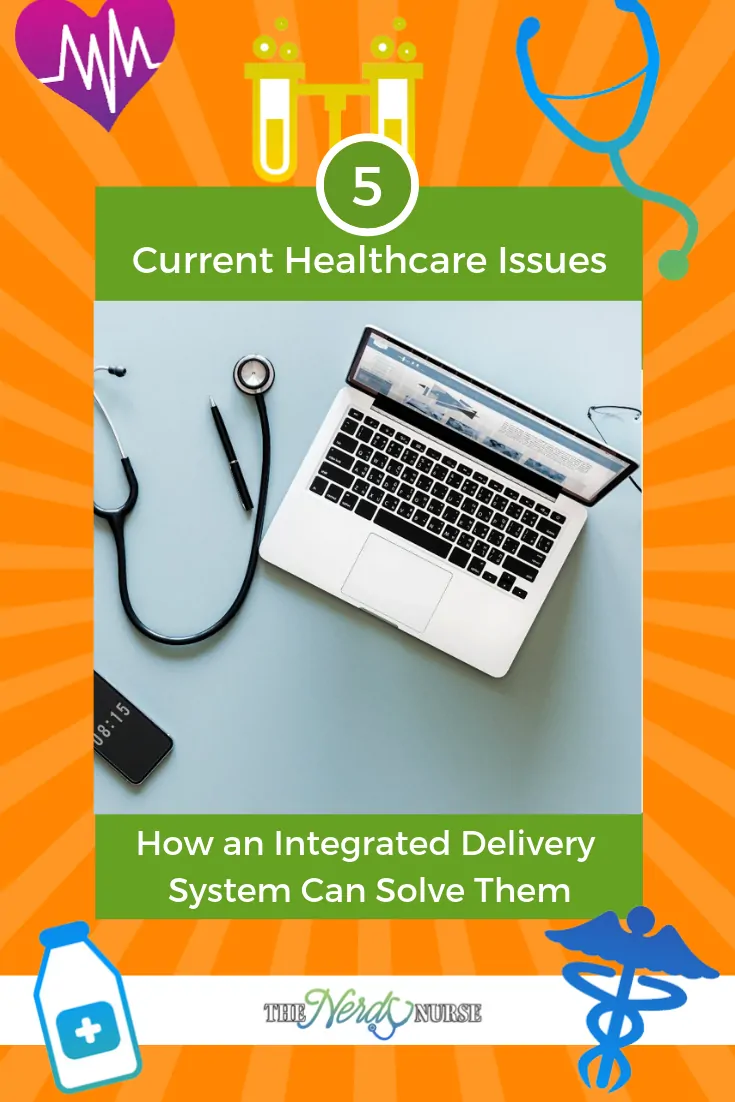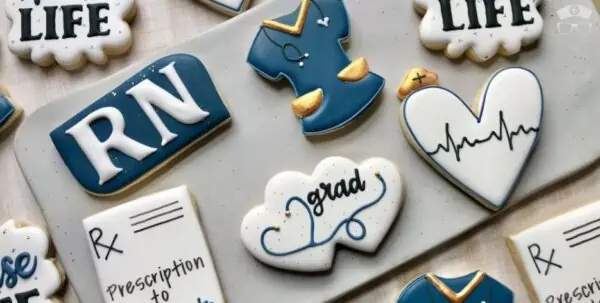This article will examine current healthcare issues and trends and discuss how an integrated delivery system can help address them.
Among all of the complications and issues that hospitals and medical practices must juggle, challenges with technology and communications simply shouldn’t be one of them. But tech challenges do happen, and far too often. We’ve partnered with Ascom to dig into these issues because they are among the many safety issues in nursing that decrease the quality of care nurses can provide. Read on to learn about 5 current healthcare issues and how an integrated delivery system can reduce their impact, and in many cases, solve the issues entirely.
What is An Integrated Delivery System?
Before we go much further, let’s answer the main question: what exactly is an integrated delivery system? Sounds complicated. But it doesn’t have to be.
An integrated delivery system (IDS), sometimes referred to as an integrated healthcare delivery system, addresses information technology issues in healthcare. Basically, it’s a system that implements the integration of the delivery of health care and fully utilizes the value of health informatics. In recent years, this term has come to focus more on integrating a health system with multiple hospitals and affiliated facilities to coordinate care (often referred to as an integrated delivery network). However, it also describes improving communications and systems within a single hospital.
There are so many communication and technology issues in healthcare, and an IDS works to address the gaps in an effort to improve the quality of care. It’s an effort to take fragmented technologies and communication infrastructures and connect them so that systems and staff communicate effectively.
In an article in the American Journal of Managed Care titled “Integrated delivery systems: the cure for fragmentation,” Alain C. Enthoven, PhD states:
Fragmentation adversely impacts quality, cost, and outcomes. Eliminating waste from unnecessary, unsafe care is crucial for improving quality and reducing costs–and making the system financially sustainable. Many believe this can be achieved through greater integration of healthcare delivery, more specifically via integrated delivery systems (IDSs).
Think about it. As a nurse trying to manage a patient’s symptoms, solving communication issues or dealing with tech that doesn’t work or communicate only hurts your patient. Fortunately, there are solutions that can fix these avoidable problems.
Current Healthcare Issues
What are the biggest challenges with communication in healthcare in the US? The most commonly cited five issues are:
- Technological
- Organizational
- Geographic
- Cultural
- Device-centric
Thankfully, an integrated delivery system can make improvements in every one of these areas. Let’s take a closer look at each issue and see how an IDS can help.
1. Technological: Gaps between systems, platforms, apps
The first challenge with communication in healthcare is technological – when there are obvious gaps between systems, platforms, and apps. This happens both on the health care provider side and the patient side.
Current healthcare trends show a continued increase in the use of tech apps by patients. So if there is missing information or the apps aren’t communicating effectively, it is essential to fix it. Without addressing it, the problem will only get worse.
An example: Patient Smith comes to you with a pre-existing condition. A different facility treated him first. But since that facility isn’t integrated into your facility’s records management software, you can’t easily access or transfer it. This leads to outdated methods of obtaining those records – like faxing them over – which slows down your patient’s treatment.
How can an IDS solve this? Simple! If Smith’s previous health care office uses the same system, you can just log in and have his entire health history at your fingertips. Or if it’s a different system, you can access a standardized format, like a continuity of care document or other information in a Health Information Exchange, to retrieve the data quickly. No gaps, quick treatment, and an easy solution.
2. Organizational: Gaps between departments, caregivers, levels of the organization
Organizational gaps between departments, caregivers, and the different levels of an organization can also impact care.
When different departments in a hospital are not on the same page, safety issues arise. For example, some nurses may misunderstand the proper chain of command, or caregivers could receive confusing information from different departments. This become obvious if a nurse floats from one floor to another and finds they follow entirely different communication practices for the same procedures and care.
These challenges bring up safety issues in nursing. How can a nurse effectively care for patients if communication issues between various physicians and people in leadership distract them?
An IDS can help resolve some of these management problems in healthcare organizations. A well-executed IDS will unify departments and prevent misunderstandings between all levels of leadership – including nurses, surgeons, and physicians.
3. Geographic: Gaps in technology, process, and functionality across locations
Of all of the healthcare issues related to communication, geography might be the most familiar to nurses. Some hospitals and health care offices use advanced technology, while others are lagging. A simple request for medical records can either be answered in a flash with the correct technology, or take extra time with outdated tech.
Gaps in process is another challenge. The order in which doctors and nurses treat patients at one location might be different at another location, and this can have an effect on the patient. Even simply going from a local doctor’s office to the nearby hospital can create frustration for the hospital physician, who is left wondering, “Why didn’t the primary care physician request this lab before the patient came here?”
A unified IDS can help solve many of today’s healthcare issues. If all nurses and health care providers follow the same processes and use the same technology, they will have more time to focus directly on the patient and their symptoms.
4. Cultural: Differences in values, beliefs, and practices across the organization
Another problem with US healthcare is the wide variety of cultural differences from one provider or office to another. There are even differences that cause issues within the same organization between the staff.
Some providers, nurses, and physicians have a strict view of treating patients with a solid scientific foundation. If it can’t be explained with science and peer-reviewed studies, it isn’t worth exploring. Others view medicine more holistically and are even open to trying out homeopathic options. Some healthcare workers pray with patients when asked, and others take a more agnostic approach.
Sometimes, these cultural differences can create communication barriers in healthcare. Let’s take an example from pop culture. The show “The Mindy Project” featured an OB/GYN named Mindy who relied on science and medicine in her practice. The midwives in her building were the opposite. Their lack of respect for each other’s views meant that when an expectant mother came from the midwives to Mindy, important details about her condition were overlooked.
The patient should never be the one to suffer. So many of the problems with US healthcare are attributable to a lack of communication. An IDS helps by creating one set of core beliefs that everyone works within. The patient safety issues in nursing become less of a worry because everyone is able to communicate effectively, knowing the values of the practice. This creates a positive culture within the healthcare organization, which benefits everyone.
5. Device: Gaps between medical and communication devices that don’t talk to each other
The final communication issue in healthcare is related to gaps between medical and communication devices that don’t work well together. Even non-medical workers know this frustration. Just try to get an Apple device to play well with an Android – the issues are real and frustrating.
Tech issues slow down diagnoses and symptom management. And who suffers? The sick patient. Healthcare communication technologies should work together seamlessly. The importance of communication in healthcare is obvious. The tools primary care physicians use need to work easily with the technology that specialists rely on so that health histories can be considered.
A really common example of this in nursing is IV pumps. Pumps are rarely integrated into the EMR/EHR system. This means that the only way that nurses know they are empty is when they start beeping. If pumps were integrated into the EMR, their status could be accessible at the nurse’s station so the nurse could be alerted before that beep starts at 4 a.m. and disturbs a patient. Ascom specializes in just this type of issue, with solutions that minimize noise pollution and reduce alarm fatigue. Providing quieter care through targeted alerts can help improve patient care, considering a recent study showed that enhancing patient rest improves patient experience.
Effective communication in health care can be accomplished with a well-established IDS. It’s like imagining a world where Apples and Androids use the same base system and can sync effortlessly. That kind of synchronicity in health care could mean the difference between life and death from some patients.
Advantages of an Integrated Delivery System
When a patient’s health can turn on a dime, having an integrated healthcare delivery system can literally save their life. There are so many bottlenecks in health care that waste precious time. Clinical workflows in healthcare rely on technology and processes. If they aren’t the same from one location to another, it can cause confusion and delays.
Healthcare management issues also take time and attention away from patients. Time spent going up the chain of command trying to solve disputes and misunderstandings is time that could be spent on a diagnosis.
When implemented corrected, an IDS enables nurses get back to nursing so they can focus less on tech problems and more on patient care.
How Ascom Can Help
Ascom is a leading provider of healthcare technologies that improve communication and safety for patients and healthcare professionals. They offer solutions and tools to help decrease fragmentation in healthcare technology and communication. Some of the solutions most impactful to nurses include:
- Smartphones like the Ascom Myco™ for managing calls, alerts, photos, messages, scores, waveforms and other critical information.
- Technologies to reduce “alarm fatigue”
- Tools that address safety issues in nursing, like the Ascom Staff Protect
- Real-time location solutions to tell you where help is needed — whether it’s an assault on staff, mislaid equipment, or a fallen or wandering patient.
You can find out more about Ascom’s solutions for healthcare by heading to Ascom North America and navigating to their hospital and senior care solutions.
Win a $4,000 Nursing Scholarship or iPad Pro from Ascom
Ascom loves nurses! To celebrate HIMSS and acknowledge the valuable role nurses play in healthcare technology, we’ve partnered with Ascom for a grand prize giveaway of a $4,000 nursing scholarship for continuing education, and a runner-up prize of an iPad Pro to help fuel your education goals. Just takes a few seconds to fill out the entry form below. Don’t forget to get your bonus entries!
Post ID#21021 is not a valid giveaway.






